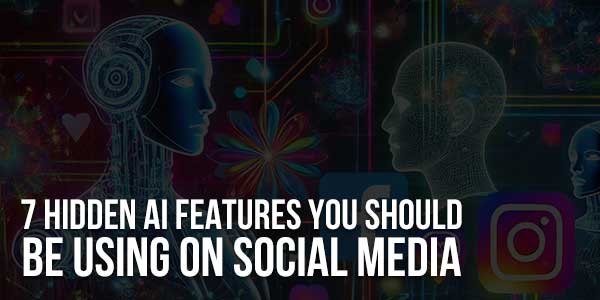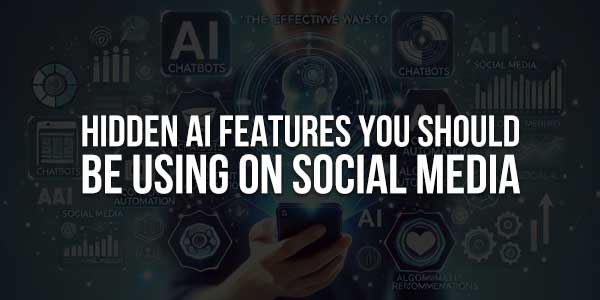
Most social media platforms now come fully stocked with smart features powered by AI, but many of the coolest are easy to glaze over. These hidden gems can help your posts pop, connect you to the right people, and potentially save you time in your day-to-day life.
By taking advantage of these hidden AI features, you will find ways to work smarter and get better results from the social platforms you use regularly. Let’s take a look at how these tools can elevate your daily features from boring to brilliant and provide you with a much-needed competitive edge on your favourite social platforms.
Table of Contents
1.) Auto-Captioning Tools To Improve Accessibility & Watch Time:
Auto-caption tools have gone from a “nice to have” to a “must-have” for every social media user. With the help of smart AI, they do much more than throw text on the video screen; they expand your content to more audiences and help keep people watching longer. Using auto-captions is one of the easiest and least impactful ways to maximise the impact of your posts.
Why Auto-Captions Matter?
Most social media users scroll through their feeds with the sound off, whether that’s because they are at work, riding the bus, or just don’t want to disturb anyone around them. If your content relies on just audio, you lose that audience quickly. Auto-captions ensure that everyone has the opportunity to engage with your content.
Auto-captions also create a more inclusive experience for viewers who are deaf or hard of hearing. Beyond accessibility, captions also attract attention and help people stay engaged, which can lead to higher views and engagement rates. When you add auto-captions to your content, you’re probably attracting some viewers who would otherwise skip your content altogether.
Top Platforms With Auto-Caption AI:
Most of the large social platforms now have some form of auto-captioning, and each does things a bit differently. If you want to capitalise on this, you need to know what’s what:
- Instagram: Helps you add live captions to Stories and Reels with a sticker or toggle. The AI does all the hard work; it recognises the words you speak and types them in a matter of seconds.
- TikTok: Contains auto-captioning during the upload. You can still review them, edit and style them before you post, all without third-party apps.
- YouTube: Relies on a much more powerful speech recognition AI to caption your videos when they are in the processing phase. You can remove or edit captions at any point as you find the need.
- Facebook: Allows you to add captions to your uploads and even your live streams, making it easy to connect with a broader audience.
It is all collected and sorted for you; all you need to do is turn on the automatic captions. The technology takes care of all the grunt work.
2.) AI-Powered Trend Prediction For Staying Ahead Of Trends:
When you’re trying to spot social media trends early, it can feel like thinking you see a wave but still trying to catch it before it crashes. If you wait too long, you miss the excitement, and you can get lost in the noise of other content. AI trend prediction tools act as your radar and give you data-driven pointers, and help you find aligned topics before they crest and hit. This tech uses massive waves of live data to target the things that are going to go “boom” and the stuff that is just “noise.” When you have the right AI tools, you don’t have to spend countless hours investigating social hashtags or news feeds – you can leverage the alert capabilities of a forecast, and it will do all the work for you.
Using these undercover AI capabilities is like hitting autopilot on your content calendar with shortcuts for reach, timing, and engagement. Here’s how the AI tools for trend prediction work and how you can leverage them.
How Do AI Tools Forecast Trends Before They Go Viral?
AI systems monitor millions of posts, tweets, images, and videos found in social apps in real-time, not just Instagram, X (Twitter), TikTok, and Facebook. AI is able to analyse large datasets using sophisticated algorithms, and its discovery provides signals that identify user usage patterns, spikes in keywords, or patterns in trends that emerge faster than the robust volume and velocity of social engagement happening.
Here are some of the primary things about what AI tools are capable of:
- A spike in unique usage of hashtags or phrases, or sounds
- Trends and patterns in signifying more complex content formats shared on larger accounts – these do not have to be high-level accounts
- Location data – so you can see localised trends that can become national or global
- The shift in sentiment (the outlook of the community) from an overall neutral to positive or negative on a trending topic
You can get a wild list of buzzwords, but good AI forecasting services help you distinguish how fast things are growing, how long the interest may last, the user/channel population that is growing, and maybe a few other things, too.
Breaking Down Predictive Tools:
Leveraging AI- forecasted trend predictions is like getting a backstage pass to where social is heading. Here’s a look at how this function changes your online play in a way that goes unnoticed:
- Increase timing: You should post on trending discussions when things are heating up and on people’s minds, rather than when things have cooled off
- Increase reach: if you jump on it early enough, your posts are more likely to create a new trend in a busy feed. Increase Conversations: You will be a part of conversations that people are having, rather than guessing what conversations people are having.
Oftentimes, we saw creators and brands take hold of new conversations only a few moments after the A.I. picked up and recognised that it was a new conversation, and they have quickly seen a massive rise in shares, comments, and, to a smaller extent, growth overall.
3.) Visual Recognition For Better Photo Tagging & Understanding:
A.I. Visual recognition has fundamentally changed the way you think about and analyse your photos on social media. The systems working behind the scenes scan each photo, classify what is actually in the photo, and supply smart suggestions for describing or categorising your content. You receive accurate tags immediately, as well as better insights about your audience and posts that are generating interest. You can have your images start to do some heavy lifting for you; these platforms can help you stay organised and extract maximum value out of every image.
How Visual Recognition Can Pull Out The Right Details?
AI image recognition can identify objects, people, places, logos, as well as emotions, in your images! The systems go beyond just faces to identify backgrounds, activities and similar objects that individuals you follow care about. Visual recognition can help with every image you upload:
- Tag or hashtag based on what is significant in the image
- Recognise brand elements like a logo, product, or packaging
- Categorise similar images together for quicker batch processing or editing
- Analyse engagement and what types of images get likes or comments
You don’t have to try to guess what trending hashtags are or try to find images by hand. Visual recognition does the undercover work for you so that you can get to creating.
Unpacking Metadata To Improve Search And Discovery:
Every image posted to social media has far more seconds worth of reporting than what you see when you upload the image. Visual recognition tools pull the hidden metadata, making any photo searchable.
Here is what to expect when you use visual recognition tools:
- Automatically-triggered alt text: This can improve accessibility and boost search ranking with a description of your image for both users and algorithms.
- Automatically tagged objects and scenes: Object detection will tag anything from shoes to sunsets, making it easy to search for your photos.
- Automatically tagged locations: This serves to provide context for travel or event photos and will instead tag place names.
The emphasis here is that by automating filling in keywords, you can help your content get found quasi-en bâton for any type of search on social media and also search engines, with no additional effort on your part. Your accounts will be more findable and followable by those who enjoy your content.

4.) Dynamic Content Personalisation With User Behaviour:
While you are clicking and scrolling, and hovering over content, social media platforms are hard at work tracking all of your user behaviours in the background. Artificial Intelligence is quietly watching. While you can be a data-generating user, it is the data that gives one of the best functional capabilities for personalisation that we know to exist today. A few strategically placed signals can enable an insane volume of changes to dynamically personalise the content of your social feeds. Brands and creators that are savvy are using these tools to place the right story in front of the right person at the right time, optimising engagement, attention, and loyalty to their brand or idea. In this section, we will look at dynamic content personalisation, how it works on social media and how to make these tools work for you.
AI Will Monitor And Respond To Your Activity:
Every click you make on a social platform is a signal: what you like, what you share, which posts you just start to watch, and which ones you rewatch are all aggregating to indicate your interest. AI is able to take this mountain of data and watch how you are engaging with their content in real time to get better at predicting what kind of content you will engage with.
AI-Responsive Personalisation is tracking time spent on posts:
- How long do you stay on a post? Did you stay on a video for a long time or look at a carousel for a while? Of course, AI is seeing this as well.
- AI-Responsive Personalisation is tracking the types of posts you engage with:
- Do you respond more to memes or how tos? Your feed will adjust to reflect the content you are most engaged with.
- AI-Responsive Personalisation is tracking your patterns of engagement:
- You comment on family pictures, but scroll through professional updates quickly? AI is taking note of your activity information.
- AI-Responsive Personalisation is tracking when you browse the most:
- Are you on the platform late at night? Your lunch breaks? The timing of your content will adjust accordingly.
The signals above are mostly high-level understandings of why each of our feeds or discovery pages may differ from each other, as every user does. You will get more of what you love, and less of what you are likely to scroll past or ignore.
Why Real-Time Content Modifications Are So Beneficial?
It is clearly possible for dynamic personalization to include content creators and social influencers, as titans, to exist at scale.
It enables everyday users to easily reach the right audience for their content. Here is how you profit:
- More engaged: Posts that align with a viewer’s expected interest get more likes, more comments, and more shares.
- Stickier: Personalised feeds encourage viewers to return to see what they missed, so your post benefits from better longevity.
- Intelligent content recycling: AI can reintroduce older posts with newer followers based on genre, if browsing signals match.
This real-time feedback loop removes the guesswork from social posting. Your message is placed in front of people who care, providing you more value for less work.
5.) Intelligent Audience Segmentation For Targeted Campaigns:
AI-based Audience segmentation is one of the best-kept secrets for placing your content in front of the right people. In a couple of clicks, these smart tools can indicate followers, page visitors, and other participating users in more deliberate groups. This is opposed to the “spray and pray” method. Instead, you can speak to someone who would notice your content and take action (i.e., purchase). With intelligent segmentation, your social media posts pack a bigger punch, and your social campaigns achieve real results without wasted efforts.
How AI Segments Your Social Media Audience?
AI audience segmentation does much more than segment by audience profile, such as age or gender. The AI tools pull together dozens of signals at once. For instance, it gives you multiple signals to extract patterns, based on followers’ browsing, purchase history, and scrolled-through habits.
The systems are factoring in, but not limited to:
- Past engagement: Likes, comments, shares, and views (profile) build the activity level of your audience segmentation.
- Interests and behaviours: AI pinpoints what topics people are engaging with most, e.g., sports, tech, and travel.
- Location and language: Connecting with local fans or speakers of a language can happen in a matter of clicks.
- Device and browsing behaviour: Analyse where your followers spend their time, on mobile or desktop, and when they are online.
- Purchase intent: We have platforms that flag when users have been interacting with shopping links or product tags on their profiles.
My approach looks at more layers of information so members can create richer segments and create campaigns that have specific applications and feel personal.
Setting Up Targeted Campaigns With AI Segments:
Once you recognise significant segments, the process is straightforward to run campaigns that relate to their needs. I have set this process up to be easier for you:
- Choose your segment: Choose the most likely group to respond to your campaign, e.g., frequent buyers or recent followers.
- Tailor your messaging: Write captions, choose images, or specific products relating to this group of interests.
- Choose the right time: Use the AI insights to publish when your segment is most active.
- Test and adjust: Monitor which messaging receives the most clicks, and fine-tune the segment for your next campaign.
AI allows you to get super specific without spreadsheets. It removes the guesswork so that every campaign can feel like a one-on-one.
AI-Based A/B Testing For Optimising Your Creative Strategy:
A/B testing powered by AI is transforming the way to improve your social media assets. No more guesswork in determining which headline, caption, or image will resonate with your audience. With AI tools enabled, you will be able to test numerous creative formats with conclusive results and short turnaround times. Before you commit your entire budget or launch a large campaign, you will know exactly what works and what doesn’t. Let’s clarify what this functionality provides and how it saves you time on social media.
AI Automation Augmenting Traditional A/B Testing:
Where traditional A/B testing required long waits and painstaking manual tracking, leading to slow decisions, AI tooling will run a test in real time and continually adjust based on your audience’s preferences and feedback. You may upload a small number of variations (based on images, video clips, subject lines, or calls to action), allowing the platform to randomly show each version to segments of the audience, capturing feedback instantly, and allowing the In-platform algorithms to drive traffic towards the performance of the material.
AI capabilities don’t just track clicks. It will also consider a multitude of signals, including, but not limited to:
- Watch time and hits on videos;
- Likes, shares, and comments on posts or ads;
- Link clicks and conversions on promoted campaigns;
- Scroll times and pauses on stories and feeds.
In short order, AI will see trends and patterns, all of which would have taken people longer previously. Once again, the best content rises to the top, and you may never again waste precious time and budget on a dud of a product.
Setting Up A/B Testing Inside Social Platforms:
Many major social channels bury their A/B testing capabilities in business or advanced features, and are straightforward formats or simple steps to execute once you know the placement.
Common placements for an A/B test include:
- Facebook/Instagram Ads Manager: This tool allows you to split-test images, headlines, buttons, and audiences in the same way that website landing page testing would allow you to do. Results will display on your dashboard right as the tests finish, and you’ll see the following apps provide the ability to conduct creative split tests for video ads, music, and/or call to actions in their Ads Manager.
- TikTok Creative Centre: Allows creative split tests for video ads, music, and calls to action.
- LinkedIn Campaign Manager: Offers A/B campaign testing for sponsored content, targeting, and ad formats.
Third-Party Options Like Hootsuite And Sprout Social Also Offer AI-Driven Testing, Making It Possible To Fine-Tune Organic Social Posts Alongside Your Paid Campaigns.
7.) Voice And Tone Analysers To Keep Messaging Consistent
While it’s important to maintain a consistent voice for your brand, a successful social media presence doesn’t come from a catchy tagline or colour palette alone. Positing through multiple platforms or working as a social team can lead to dissonance in your messaging, and voice and tone analysers powered by AI give you that little leg up. These features continuously check everything you write to help you stay true to your voice, which means your audience can count on your consistency, whether you post a tweet, a story, or you’re replying to comments.
Voice and tone analysers don’t stop at spelling and grammar checks; they serve more like a mirror for how you present your message, allowing your followers to recognise you, even when you’re busy or acting as part of a social team.
What Voice And Tone Analysers Do?
They’ll also let you know if your content has an overly formal or casual tone when compared to how you typically communicate. You get seamless content consistency without sounding inauthentic.
With These Features, You Can:
- Identify when your posts have a far too strict or casual a tone for your brand.
- Review drafts against style guides or previous posts
- Receive some advice on how to reword your content with a more friendly, authoritative, or approachable tone
Flag some potentially risky language that may confuse or offend your audience
If you can make these changes before you publish your content, you won’t confuse your audiences with mixed signals. Your followers will experience a smooth and consistent connection to your brand or business when you post about a new product launch or a fun behind-the-scenes post.
Why Consistency In Messaging Is Important?
Now, let’s break down the importance of having a steady voice for growth and trust.
- Familiarity allows followers to recognise, remember, and expect you to behave in certain ways when they see something pop up in their feed.
- Trust gets kicked to a new level because your talking style isn’t going to change with every new update.
- Less confusion, because they will instantly recognise your posts, even if the visuals or topics change.
Lose this focus and you may cause your audience to disengage and/or wonder if they are still engaging with the right account. Consistency reinforces your identity and allows each post to work harder for you.
Conclusion:
Making sense of and utilizing the best AI features that exist all around us on social media tools can help you work more efficiently and effectively, rather than “harder.” From auto-captioning, trending content, tags, to images available instantly, highly personalised content, smart segmentation, rapid A/B testing, voice analysers, to name a few, these tools have great potential to change your results, your life, and/or your everyday routine.
Utilising a few of these features will help focus your message and help you build better relationships with the people who mean the most to your brand. Keep an eye out for new AI-driven tools as social media platforms update frequently. Start with one feature, measure the impact, and let your audience’s reaction indicate your next move.














Be the first to write a comment.